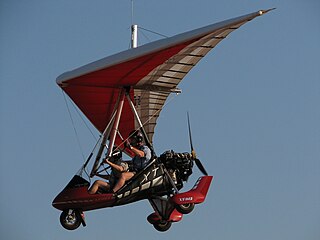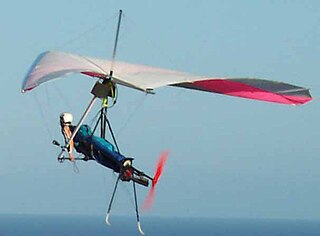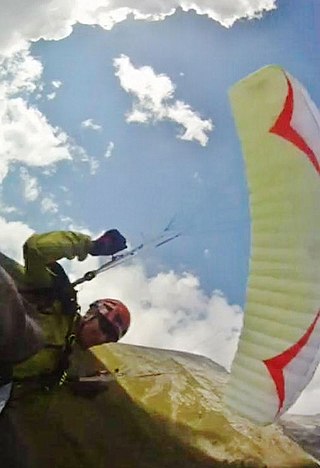
Hang gliding is an air sport or recreational activity in which a pilot flies a light, non-motorised, heavier-than-air aircraft called a hang glider. Most modern hang gliders are made of an aluminium alloy or composite frame covered with synthetic sailcloth to form a wing. Typically the pilot is in a harness suspended from the airframe, and controls the aircraft by shifting body weight in opposition to a control frame.

Paragliding is the recreational and competitive adventure sport of flying paragliders: lightweight, free-flying, foot-launched glider aircraft with no rigid primary structure. The pilot sits in a harness or in a cocoon-like 'pod' suspended below a fabric wing. Wing shape is maintained by the suspension lines, the pressure of air entering vents in the front of the wing, and the aerodynamic forces of the air flowing over the outside.

The Rogallo wing is a flexible type of wing. In 1948, Francis Rogallo, a NASA engineer, and his wife Gertrude Rogallo, invented a self-inflating flexible wing they called the Parawing, also known after them as the "Rogallo Wing" and flexible wing. NASA considered Rogallo's flexible wing as an alternative recovery system for the Mercury and Gemini space capsules, and for possible use in other spacecraft landings, but the idea was dropped from Gemini in 1964 in favor of conventional parachutes.

Francis Melvin Rogallo was an American aeronautical engineer inventor born in Sanger, California, U.S. Together with his wife, he is credited with the invention of the Rogallo wing, or "flexible wing", a precursor to the modern hang glider and paraglider. His patents were ranged over mechanical utility patents and ornamental design patents for wing controls, airfoils, target kite, flexible wing, and advanced configurations for flexible wing vehicles.

Powered paragliding, also known as paramotoring or PPG, is a form of ultralight aviation where the pilot wears a back-pack motor which provides enough thrust to take off using a paraglider. It can be launched in still air, and on level ground, by the pilot alone—no assistance is required.

An ultralight trike or paratrike is a type of powered hang glider where flight control is by weight-shift. These aircraft have a fabric flex-wing from which is suspended a tricycle fuselage pod driven by a pusher propeller. The pod accommodates either a solo pilot, or a pilot and a single passenger. Trikes grant affordable, accessible, and exciting flying, and have been popular since the 1980s.

Hang gliding is an air sport employing a foot-launchable aircraft. Typically, a modern hang glider is constructed of an aluminium alloy or composite-framed fabric wing. The pilot is ensconced in a harness suspended from the airframe, and exercises control by shifting body weight in opposition to a control frame.

A foot-launched powered hang glider (FLPHG), also called powered harness, nanolight, or hangmotor, is a powered hang glider harness with a motor and propeller often in pusher configuration, although some can be found in tractor configuration. An ordinary hang glider is used for its wing and control frame, and the pilot can foot-launch from a hill or from flat ground, needing a length of about a football field to get airborne, or much less if there is an oncoming breeze and no obstacles.

A glider is a fixed-wing aircraft that is supported in flight by the dynamic reaction of the air against its lifting surfaces, and whose free flight does not depend on an engine. Most gliders do not have an engine, although motor-gliders have small engines for extending their flight when necessary by sustaining the altitude with some being powerful enough to take off by self-launch.
Bruce Goldsmith is a British paraglider pilot, paraglider designer, and the 2007 Paragliding World Champion. He won the title at Manilla in Australia, flying an Airwave Magic FR3.

Speed-flying and speed-riding are advanced disciplines close to paragliding that use a small, high-performance non-rigid wing to quickly descend heights such as mountains. Speed flying and speed riding are very similar sports; speed flying is when the speed wing is foot-launched, while speed riding is a winter sport done on skis.
Wills Wing, Inc. is an American aircraft manufacturer based in Orange, California and previously located in Santa Ana, California. The company specializes in the design and manufacture of hang gliders in the form of ready-to-fly aircraft, plus hang glider harnesses and accessories.

Aerodyne Technologies was a French aircraft manufacturer based in Étrembières and previously based in Talloires. The company specialized in the design and manufacture of paragliders and reserve parachutes.
The Airwave Magic is an Austrian single-place, paraglider that was designed by Bruce Goldsmith and produced by Airwave Gliders of Fulpmes. It is now out of production.
The Airwave Scenic is an Austrian two-place, paraglider that was designed by Bruce Goldsmith and produced by Airwave Gliders of Fulpmes. It is now out of production.
The Airwave Ten is an Austrian single-place, paraglider that was designed by Bruce Goldsmith and produced by Airwave Gliders of Fulpmes. It is now out of production.
The Airwave Wave is an Austrian single-place, paraglider that was designed by Bruce Goldsmith and produced by Airwave Gliders of Fulpmes. It is now out of production.
Ozone Gliders Limited is an aircraft manufacturer based in Le Bar-sur-Loup, France, although it is registered in Edinburgh, Scotland. The company specializes in the design and manufacture of paragliders in the form of ready-to-fly aircraft.
Sol Paragliders is a Brazilian aircraft manufacturer based in Jaraguá do Sul and founded by Ary Carlos Pradi. The company specializes in the design and manufacture of paragliders and paramotor wings in the form of ready-to-fly aircraft. The company also produces paragliding harnesses, rescue parachutes and accessories.
UP International GmbH is a German aircraft manufacturer based in Garmisch-Partenkirchen. The company specializes in the design and manufacture of paragliders in the form of ready-to-fly aircraft. The company started business as a hang glider manufacturer based in the United States.










